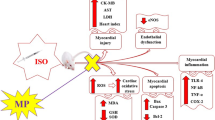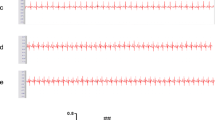Abstract
Background
Ligands of peroxisome proliferator–activated receptor alpha (PPAR–α) have been shown to reduce ischaemia/reperfusion injury. The mechanisms behind this effect are not well known. We hypothesized that activation of PPAR–α exerts cardioprotection via a mechanism related to nitric oxide (NO) and endothelin–1 (ET–1).
Methods
Five groups of anaesthetized open–chest Sprague–Dawley rats were given the PPAR–α agonist WY 14643 1 mg/kg (WY; n = 7), dimethyl sulfoxide (DMSO, vehicle for WY; n = 6), the combination of WY and the NO synthase inhibitor N–nitro–L–arginine (L–NNA, 2 mg/kg) (n = 7), L–NNA only (n = 8) or 0.9% sodium chloride (NaCl, vehicle for DMSO and L–NNA; n = 8) i.v. before a 30 min period of coronary artery occlusion followed by 2 h of reperfusion. Infarct size (IS), eNOS and iNOS protein and ET–1 mRNA expression were determined.
Results
There were no haemodynamic differences between the groups during the experiment. The IS was 78 ± 3% of the area at risk in the DMSO group and 77 ± 2% in the NaCl group (P = NS). WY reduced IS to 56 ± 3% (P < 0.001 vs. DMSO group). When WY was administered in combination with L–NNA the cardioprotective effect was abolished (IS 73 ± 3%, P < 0.01 vs. WY 14643). L–NNA did not affect IS per se (78 ± 2%, P = NS). The expression of eNOS but not iNOS protein in ischaemic myocardium from rats was increased in the group given WY (P < 0.05). ET–1 mRNA levels were lower in the ischaemic myocardium following WY administration.
Conclusion
The results suggest that the PPAR–α activation protects the rat myocardium against ischaemia/ reperfusion injury via a mechanism related to production of NO, and possibly ET–1.
Similar content being viewed by others
References
(2001) Effect of fenofibrate on progression of coronary–artery disease in type 2 diabetes: the Diabetes Atherosclerosis Intervention Study, a randomised study. Lancet 357:905–910
Amrani M, Chester AH, Jayakumar J, Schyns CJ, Yacoub MH (1995) L–arginine reverses low coronary reflow and enhances postischaemic recovery of cardiac mechanical function. Cardiovasc Res 30:200–204
Beckman JS, Koppenol WH (1996) Nitric oxide, superoxide, and peroxynitrite: the good, the bad, and ugly. Am J Physiol 271:C1424–1437
Bell RM, Maddock HL, Yellon DM (2003) The cardioprotective and mitochondrial depolarising properties of exogenous nitric oxide in mouse heart. Cardiovasc Res 57:405–415
Bishop–Bailey D (2000) Peroxisome proliferator– activated receptors in the cardiovascular system. Br J Pharmacol 129:823–834
Capell WH, DeSouza CA, Poirier P, Bell ML, Stauffer BL, Weil KM, Hernandez TL, Eckel RH (2003) Short–term triglyceride lowering with fenofibrate improves vasodilator function in subjects with hypertriglyceridemia. Arterioscler Thromb Vasc Biol 23:307–313
Chinetti G, Griglio S, Antonucci M, Torra IP, Delerive P, Majd Z, Fruchart JC, Chapman J, Najib J, Staels B (1998) Activation of proliferator–activated receptors alpha and gamma induces apoptosis of human monocyte–derived macrophages. J Biol Chem 273:25573–25580
Delerive P, Martin–Nizard F, Chinetti G, Trottein F, Fruchart JC, Najib J, Duriez P, Staels B (1999) Peroxisome proliferatoractivated receptor activators inhibit thrombin–induced endothelin–1 production in human vascular endothelial cells by inhibiting the activator protein–1 signaling pathway. Circ Res 85:394–402
Fishbein MC, Meerbaum S, Rit J, Lando U, Kanmatsuse K, Mercier JC, Corday E, Ganz W (1981) Early phase acute myocardial infarct size quantification: validation of the triphenyl tetrazolium chloride tissue enzyme staining technique. Am Heart J 101:593–600
Furchgott RF, Zawadzki JV (1980) The obligatory role of endothelial cells in the relaxation of arterial smooth muscle by acetylcholine. Nature 288:373–376
Giraldez RR, Panda A, Xia Y, Sanders SP, Zweier JL (1997) Decreased nitric–oxide synthase activity causes impaired endothelium–dependent relaxation in the postischemic heart. J Biol Chem 272:21420–21426
Gourine AV, Bulhak AA, Gonon AT, Pernow J, Sjoquist PO (2002) Cardioprotective effect induced by brief exposure to nitric oxide before myocardial ischemiareperfusion in vivo. Nitric Oxide 7:210–216
Goya K, Sumitani S, Xu X, Kitamura T, Yamamoto H, Kurebayashi S, Saito H, Kouhara H, Kasayama S, Kawase I (2004) Peroxisome proliferator–activated receptor alpha agonists increase nitric oxide synthase expression in vascular endothelial cells. Arterioscler Thromb Vasc Biol 24:658–663
Hawkins HK, Entman ML, Zhu JY, Youker KA, Berens K, Dore M, Smith CW (1996) Acute inflammatory reaction after myocardial ischemic injury and reperfusion. Development and use of a neutrophil– specific antibody. Am J Pathol 148:1957–1969
Heusch G, Post H, Michel MC, Kelm M, Schulz R (2000) Endogenous nitric oxide and myocardial adaptation to ischemia. Circ Res 87:146–152
Inoue I, Shino K, Noji S, Awata T, Katayama S (1998) Expression of peroxisome proliferator–activated receptor alpha (PPAR alpha) in primary cultures of human vascular endothelial cells. Biochem Biophys Res Commun 246:370– 374
Jordan JE, Zhao ZQ, Vinten–Johansen J (1999) The role of neutrophils in myocardial ischemia–reperfusion injury. Cardiovasc Res 43:860–878
Kobara M, Tatsumi T, Takeda M, Mano A, Yamanaka S, Shiraishi J, Keira N, Matoba S, Asayama J, Nakagawa M (2003) The dual effects of nitric oxide synthase inhibitors on ischemia–reperfusion injury in rat hearts. Basic Res Cardiol 98:319–328
Krey G, Braissant O, L'Horset F, Kalkhoven E, Perroud M, Parker MG, Wahli W (1997) Fatty acids, eicosanoids, and hypolipidemic agents identified as ligands of peroxisome proliferator–activated receptors by coactivator–dependent receptor ligand assay. Mol Endocrinol 11:779–791
Kubes P, Suzuki M, Granger DN (1991) Nitric oxide: an endogenous modulator of leukocyte adhesion. Proc Natl Acad Sci USA 88:4651–4655
Lefer DJ, Nakanishi K, Johnston WE, Vinten– Johansen J (1993) Antineutrophil and myocardial protecting actions of a novel nitric oxide donor after acute myocardial ischemia and reperfusion of dogs. Circulation 88:2337–2350
Marx N, Sukhova GK, Collins T, Libby P, Plutzky J (1999) PPARalpha activators inhibit cytokine–induced vascular cell adhesion molecule–1 expression in human endothelial cells. Circulation 99:3125–3131
Maxwell MP, Hearse DJ, Yellon DM (1987) Species variation in the coronary collateral circulation during regional myocardial ischaemia: a critical determinant of the rate of evolution and extent of myocardial infarction. Cardiovasc Res 21:737–746
Neve BP, Fruchart JC, Staels B (2000) Role of the peroxisome proliferator–activated receptors (PPAR) in atherosclerosis. Biochem Pharmacol 60:1245–1250
Pernow J, Wang QD (1997) Endothelin in myocardial ischaemia and reperfusion. Cardiovasc Res 33:518–526
Playford DA, Watts GF, Best JD, Burke V (2002) Effect of fenofibrate on brachial artery flow–mediated dilatation in type 2 diabetes mellitus. Am J Cardiol 90:1254– 1257
Rubanyi GM, Vanhoutte PM (1986) Superoxide anions and hyperoxia inactivate endothelium–derived relaxing factor. Am J Physiol 250:H822–827
Ruotolo G, Ericsson CG, Tettamanti C, Karpe F, Grip L, Svane B, Nilsson J, de Faire U, Hamsten A (1998) Treatment effects on serum lipoprotein lipids, apolipoproteins and low density lipoprotein particle size and relationships of lipoprotein variables to progression of coronary artery disease in the Bezafibrate Coronary Atherosclerosis Intervention Trial (BECAIT). J Am Coll Cardiol 32:1648–1656
Staels B, Koenig W, Habib A, Merval R, Lebret M, Torra IP, Delerive P, Fadel A, Chinetti G, Fruchart JC, Najib J, Maclouf J, Tedgui A (1998) Activation of human aortic smooth–muscle cells is inhibited by PPARalpha but not by PPARgamma activators. Nature 393:790–793
Steinmetz M, Quentin T, Poppe A, Paul T, Jux C (2005) Changes in expression levels of genes involved in fatty acid metabolism: upregulation of all three members of the PPAR family (alpha, gamma, delta) and the newly described adiponectin receptor 2, but not adiponectin receptor 1 during neonatal cardiac development of the rat. Basic Res Cardiol 100:263–269
Tickerhoof MM, Farrell PA, Korzick DH (2003) Alterations in rat coronary vasoreactivity and vascular protein kinase C isoforms in Type 1 diabetes. Am J Physiol Heart Circ Physiol 285:H2694–2703
Uddman E, Henriksson M, Eskesen K, Edvinsson L (2003) Role of mitogen–activated protein kinases in endothelin ETB receptor up–regulation after organ culture of rat mesenteric artery. Eur J Pharmacol 482:39–47
Wayman NS, Ellis BL, Thiemermann C (2002) Ligands of the peroxisome proliferator– activated receptor–PPAR–a reduce myocardial infarct size. Med Sci Monit 8:BR243–247
Wayman NS, Hattori Y, McDonald MC, Mota–Filipe H, Cuzzocrea S, Pisano B, Chatterjee PK, Thiemermann C (2002) Ligands of the peroxisome proliferatoractivated receptors (PPAR–gamma and PPAR–alpha) reduce myocardial infarct size. Faseb J 16:1027–1040
Wennmalm A (1994) Endothelial nitric oxide and cardiovascular disease. J Intern Med 235:317–327
Yue TL, Bao W, Jucker BM, Gu JL, Romanic AM, Brown PJ, Cui J, Thudium DT, Boyce R, Burns–Kurtis CL, Mirabile RC, Aravindhan K, Ohlstein EH (2003) Activation of peroxisome proliferatoractivated receptor–alpha protects the heart from ischemia/reperfusion injury. Circulation 108:2393–2399
Zhang R, Min W, Sessa WC (1995) Functional analysis of the human endothelial nitric oxide synthase promoter. Sp1 and GATA factors are necessary for basal transcription in endothelial cells. J Biol Chem 270:15320–15326
Author information
Authors and Affiliations
Corresponding author
Rights and permissions
About this article
Cite this article
Bulhak, A.A., Sjöquist, PO., Xu, CB. et al. Protection against myocardial ischaemia/reperfusion injury by PPAR–α activation is related to production of nitric oxide and endothelin–1. Basic Res Cardiol 101, 244–252 (2006). https://doi.org/10.1007/s00395-005-0580-1
Received:
Revised:
Accepted:
Published:
Issue Date:
DOI: https://doi.org/10.1007/s00395-005-0580-1




